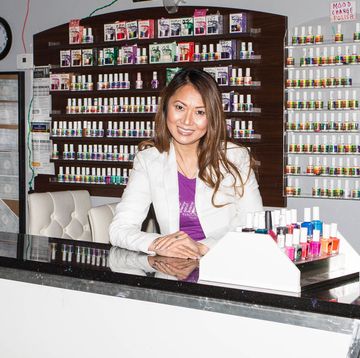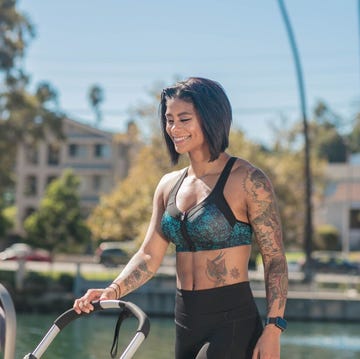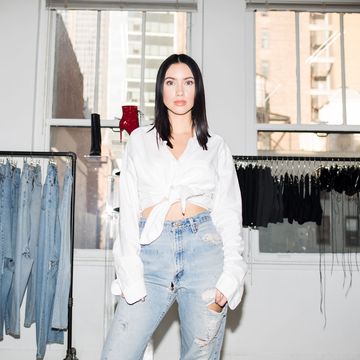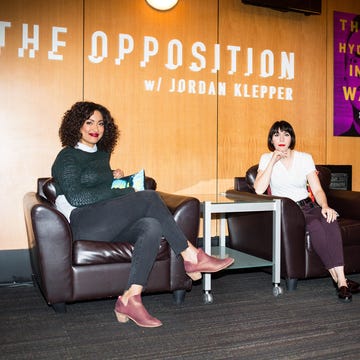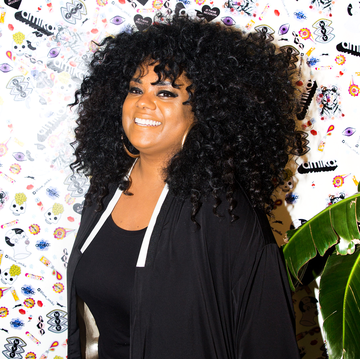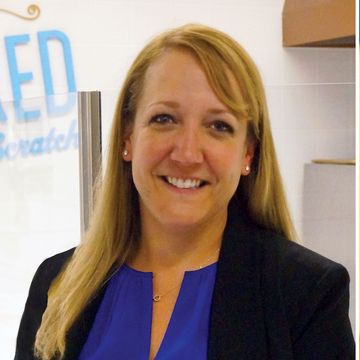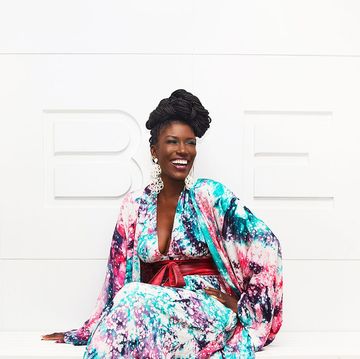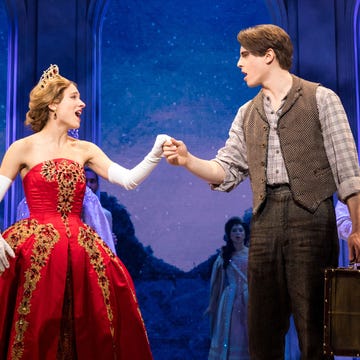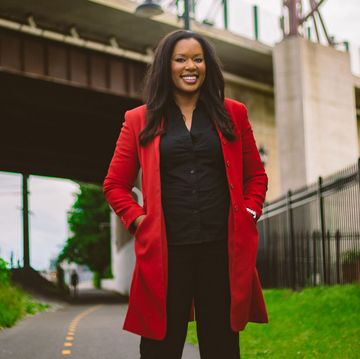Walk into Olive boutique in Austin and you feel like you've stepped into a perfectly Instagrammed photo on your favorite style blog. Cowhide rugs splay across the floors of the bungalow building, and racks of clothes — mostly pieces from independent designers and some choice vintage finds — line the perimeter. There are stacks of cool-girl Austin essentials like high-waisted denim cutoffs and lightweight jumpsuits, and sweet but not precious indulgences like gold-arrow necklaces, printed tights, and hair-thin rings. Laura Uhlir, the store's 29-year-old owner, talked to Cosmopolitan.com about her style inspirations and how to strike out on your own.
I grew up on a farm in Longview, Texas. I use the term "farm" loosely, but we had cows and chickens and goats. I loved animals, and for a while thought I might be a vet or a marine biologist, but I realized that would involve science, and I'm a little more left-brained.
I went to college at UT Austin and majored in visual arts studies — a combination of studio art, art history, and art education. I thought I wanted to be an art teacher, in part because in my family, there are a lot of teachers, so it was the natural choice. Then my last year of college I realized, This isn't what I want to do. But I didn't know what I wanted.
All through college I worked at Sephora as a makeup artist. After I graduated, I got a job at a boutique selling upscale women's clothes. It seemed like everybody working there was in some weird stopgap, a sort of "What are we doing with our lives?" kind of place. One of my coworkers was going to beauty school, and she kept trying to convince me to go. So I went to beauty school for a little bit and dropped out. I'm an actual beauty school dropout.
The reason I left is my husband, my boyfriend at the time, got into grad school in Santa Barbara, for an MFA in painting. I was like, "OK, I'll go with you," and I guess he was like, "Oh shit, she's really serious," because he proposed and we got married and moved to Santa Barbara. I worked at a little art gallery for this amazing 90-year-old woman. She used to have a rug shop in the '70s, and she sold Moroccan and Turkish rugs to Jim Morrison and people like that. I was her "gallery director" for years, but I was really just her gal pal. We drank coffee and talked about cooking.
I was incredibly homesick the whole time we were in California. In hindsight it's a beautiful, wonderful place, but I hated it and could not wait to get back, so I was looking for jobs the last few months we were there. A job came up at the Blanton Art Museum at the University of Texas for an assistant events coordinator, so I flew out and interviewed and got the job. I worked at the Blanton for about a year after we came back from California. I coordinated all the private and public events for the museum: setting up events for donors, working with the caterers and the DJs and the florists, organizing big public parties for the city, doing all the layout, like, "We should put two cocktail tables here."
It was a really fun job, but my boss really hated me. She made it relatively clear that she had a paper trail going trying to fire me. She had this tough alpha female thing going, and I think I was generally well liked at the museum and it seemed she was threatened by that. I didn't get the chance to do what I could have done there. I thought I was pretty good at my job, but it's hard to work in a minefield.
At the same time friends of mine in Houston were starting a store, and they said, "Why don't you come be our buyer? You hate your job. You're good at this." I am a bit of a shopping addict and I keep up to date with that sort of stuff, so I quit my job to be their buyer and help launch their store.
The store is called Settlement. I didn't want to move to Houston, because my husband and I had just moved back to Austin and bought a house. I drove back and forth a lot — it's only three hours — but it eventually became too complicated. We didn't even technically get to the buying point. Their concept is American-made goods, so I did research and found as many great designers as I could that produced in America. We also did a New York trip for more research — going to other boutiques, going to trade shows. I started reaching out to designers to say, "We're this little store, and we like you." When I started my shop, I knew what to do, even though I was just winging it with them.
After their store launched, I was like, "That was really fun. I want a store!" After that I had the bug and started planning for this.
After I left that job, I had a little break, didn't do much for a little bit — maybe a couple months where I was like, "What am I gonna do?" Then a friend who owns a now-defunct bookshop-gallery called Domy was trying to condense the shop and lease out a portion of the space to another shop.
Luckily I started out primarily with vintage, because it's accessible and I always had a soft spot for it. I grew up in East Texas where there's nothing cool at all, so I was a little thrift-store rat. If I had an afternoon where I had nothing to do, I would go dig through the bins. There's a Neiman's distributor in Longview, and there's this charity shop that gets the returns and floor models from Neiman's, and all the shoes were $40, like Manolos or Chanel flats. I had an eBay store going for a while from that shop.
I threw the store together in six weeks. It helped that I didn't have to do a build-out. It was in an existing store with an existing customer base that kind of overlapped — a creative group, since it was a bookstore and an art gallery. I opened it on my birthday, September 1, 2012.
I wasn't in that space for very long at all — maybe five months — because the main store closed. The owner was going through a divorce and it got messy and weird, and the guy who ran the shop decided he didn't have the energy to take it on without the backer.
I was inside Domy with another little shop called Paper Party, a stationery and party goods store, and the owner of that store and I were in the same boat of wanting to open stores but not sure how. When Domy closed, she and I and another partner, a woman who runs a shop called Sound & True, decided to look around for another spot, and we found the place I'm in now. It was the only place we looked at, and we were just like, "Sure, we'll take it!" I love this neighborhood, and we knew it was a good location. The rent was cheap at the time — it's not anymore. That was in February of 2013.
It was a nightmare to get this place ready. It was a bitch. It was a lot of late nights. The woman from Paper Party had just found out she was pregnant, so she couldn't do any painting or heavy lifting. We hired someone to do a little bit of the build-out, but it was mainly me and the other partner with a paintbrush for six weeks going crazy. It was backbreaking. But it's that sort of thing where you don't think about it, because if you thought about it, you wouldn't do it. You work 12-hour days for days on end. We operated under the moniker Rosewood Collective, though I have since rebranded the shop to just Olive since I am the only business in the space now.
Luckily we both had some fixtures from our shops in Domy. And I've done it piecemeal, buying things when I have a little bit of extra money. I used a couple thousand dollars of personal savings, but compared to what most people spent on stores, we spent nothing. We spent maybe $5,000 in total — if you include our deposit and rent, it was a little more than that. Most people spend $20,000 or $50,000 or even $100,000 building a store. We got donated paint that people had left over, we used paintbrushes we had in our garage, we had a friend who's a woodworker who did some of the build-out at a discount. It was very scrappy and tiny. Not that it's super slick now, but it's a lot more together than it was at the time. It was like an awkward teenager at that point.
The front is the actual store, and in the back we have studio space. It helps financially to have someone sharing the burden of rent and bills, and I know how hard it is to find affordable studios in Austin. It was just a happy accident to get to offer space to people who need it. It's symbiotic. There are five studios. My husband has one, and artists and creative professionals use the other four.
I work at the store five days a week, we're closed on Mondays, and I have a woman named Leah who works Sundays. She's one of the studio tenants, so rather than paying studio rent to me, she works one day a week. I was working six days a week for a very long time. One day off a week is not enough. I was spending my day off on errands and doing stuff for the shop. Now I have a day where I can actually go swimming or sleep in or go to brunch or whatever people do with their downtime.
Now much of the store is stocked with items made by smaller designers, but we still have some vintage and I still do a lot of thrifting. I go to thrift stores and estate sales and garage sales, and I look on eBay and I buy from friends. Anywhere I can get vintage, I do. I get a lot in East Texas, but my favorite place to get vintage is in California, just because there's so much. I try to do a big buying trip whenever I can. As long as you're looking hard enough, you can find something anywhere. I never walk out of anywhere empty-handed. I do the shopping on my days off. It's getting to a breaking point, but I still actually enjoy that as recreation; it's still relaxing and fun to me, although it does get a little tedious. I do it when I go on vacation, much to my husband's chagrin.
To find the items that aren't vintage, I spend the majority of my time doing what you could generously call "research," which basically means I'm on the Internet all the time. I read blogs, I look at Etsy, I look at designers' pages, and I just reach out to them and say I would love to have them in my store. Nine times out of 10, they say, "Yay thanks! Here's my info and you can buy whatever you want." Designers also approach me to see if I'm interested in carrying their line. Blogs are a great way to find people, because you see what people are writing about and what they want. Some of my favorites are Miss Moss, Cali Vintage, Size Too Small, Pennyweight, and Honey Kennedy.
Twice a year I go to New York for market, where designers from all over the country are set up showing their collections. You write orders, and it comes in maybe six months later.
My store is also online. We sell more in store — maybe 35/65 online/in-store. It's not a huge portion of my sales, but I would be very sad if I didn't have my web shop. It draws in customers from everywhere — I have people from Australia, from Spain, L.A., Brooklyn, Chicago, San Francisco, and actually Austin too. But running an online shop is almost as much time and work as running a physical shop. People take for granted how much work goes into an online store. If I could, I would hire someone just to work for my online store, to take gorgeous photos, and measure everything and write the descriptions — that's what most large successful stores do. They have a dedicated team to their website. I do everything now. The only thing I don't do is model the clothes — I have a girlfriend who looks great in everything. She just had a baby, and she looks perfect. It's so unfair.
Paper Party is no longer involved in the store; neither is the other partner. The Paper Party owner had a baby last summer, and she wanted to move her store online and just be at home and spend more time with her daughter. Her store is still open online, and she also has a pop-up shop inside of a local art gallery, but she's been there since January, so it seems relatively permanent. I hope it is!
The hardest part is never being off the clock. You're always at work, even when you're at home or asleep or on vacation. It's always in the back of your mind. If anything goes wrong, it's on you. Even when you're at the beach, you've got your phone right next to you. I love it, so I'm not complaining, but you never really check out 100 percent.
Finances can also be scary. I'm so scared for fall, because I've been on an uphill climb of growing my inventory, and of course invoices and bills get bigger and bigger, and I'm going to get hit with really big ones. In theory you spend a ton, but you make more when someone buys it, but there's a week there where you have like $80 and you're like, "Oh my god, I have all these invoices. What if no one buys anything?" But then you have a great weekend and you pay off your credit card and it's fine. It's so up and down, but I've learned that's just how it goes.
My advice to people thinking of starting their own stores or small businesses is don't overthink it. I don't know if that's good advice or not. Of course, I was lucky — I got to start without spending much money. But people often sit on passion projects and plan every detail, but I think learning as you go is just as effective. It worked for me anyway. Don't be scared to reach out to people. There's a woman in L.A. who owns a boutique very similar to mine, and I didn't know her at all, but just before I opened, I visited her shop, and we got to chatting and emailing and Instagramming. Now we talk on the phone super-often and travel together to do our buying. We're good friends. Asking how she did things was really helpful. If you are opening a store, you should reach out to other shops you love and ask questions. I've had two or three people reach out to my shop and I try to pass on the karma and help them how I can. There are no stupid questions.
Get That Life is a weekly series that reveals how successful, talented, creative women got to where they are now. Check back each Monday for the latest interview.
Correction: This piece has been edited to reflect the involvement of another partner when the store opened.
RELATED:
Get That Life: How I Became a First Amendment LawyerGet That Life: How I Became a Professional Cheese EaterGet That Life: How I Founded Jezebel and Became a New York Times ColumnistGet That Life: How I Used Social Media to Become a World-Famous Yoga InstructorGet That Life: How I Turned Bize-Size Cupcakes Into a Successful Business
Follow Jill on Twitter.
Photo credit: Kathleen Kamphausen for Cosmopolitan.com.

Jill Filipovic is a contributing writer for cosmopolitan.com. She is the author of OK Boomer, Let's Talk: How My Generation Got Left Behind and The H-Spot: The Feminist Pursuit of Happiness. A weekly CNN columnist and a contributing writer for the New York Times, she is also a lawyer.


